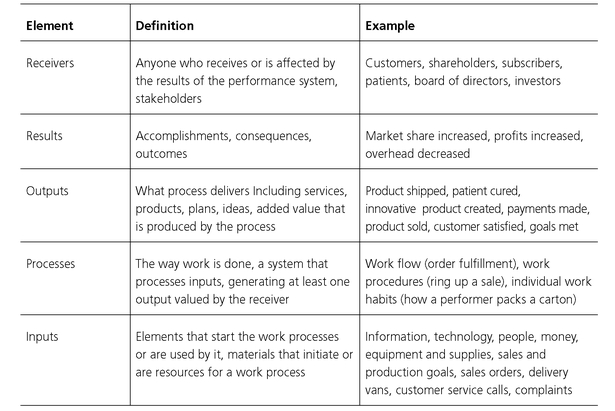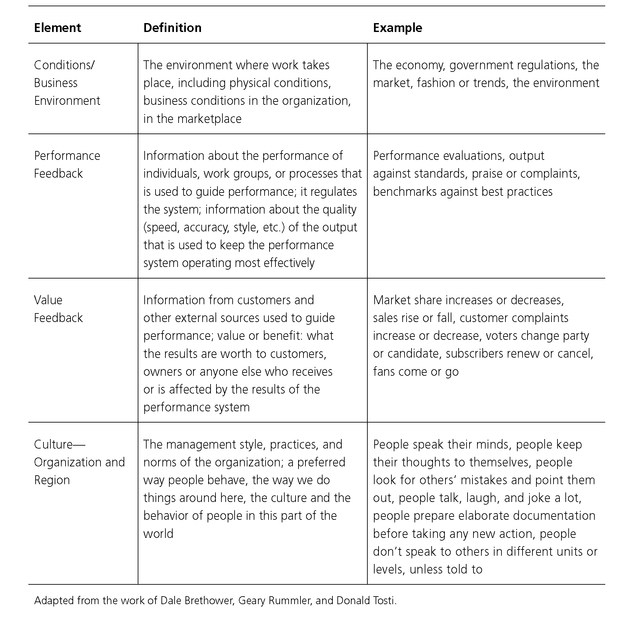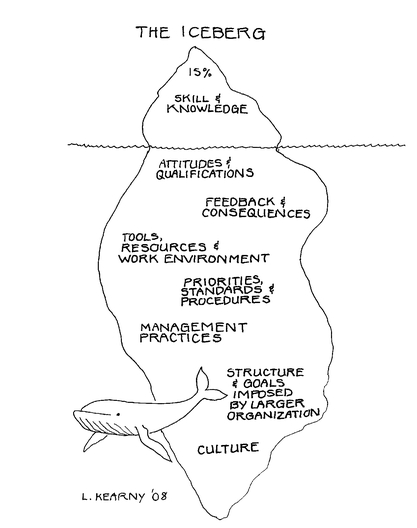HELPFUL MODELS AND TOOLS
Despite your skills, experience, and personal charm, much of your professional credibility and success in performance improvement comes from your knowledge of which models and tools can help expand your understanding of your client’s problems and opportunities. We share three of our favorites with you here: the Total Performance System, the Performance Map, and the Iceberg.
Total Performance System
The second principle of Performance Technology, as discussed in Chapter 1, The Performance Technology Landscape, is “Take a system view” or think systemically. Every organization is a system. Understanding the elements of this total performance system and how they interact is one of the keys to superior performance consulting, because any change in one part of the system will ultimately affect all its parts.
There are two views of an organization that can be helpful. One perspective is from the traditional organization chart, a functional view, and the other is from a system viewpoint. The system viewpoint is an efficient way to identify critical indicators, interdependencies, changes, and unique characteristics.
Performance, as defined in Chapter 1, The Performance Technology Landscape, is activities plus results. There is no performance unless both conditions are met. We use the Total Performance System to show us the components of performance in a client organization and to specify the results produced. Table 2.1 is a way to organize the elements. Review the definition for each element in the table, consult the appropriate examples for guidance, and list the specifics for your client organization.
TABLE 2.1. Total Performance System.


We like the Total Performance System because it helps us organize what we learn about an organization as we clarify our understanding of the activities and results that produce performance in that environment. We find this model to be scalable; it is as effective for an entire global organization as it is for one division or department.
The Performance Map
We find that we can increase the likelihood of a successful performance improvement engagement when we involve the requestor at the start. The Performance Map is a particularly useful tool to help a client move from requesting a training solution to understanding why a performance solution may be more effective.
The Performance Map in Figure 2.1 helps diagnose performance-related issues. Whether to solve a problem or create an opportunity, the Performance Map’s simple grid format is easy to explain to managers who often respond by picking up a pen and actively engaging with the Map (Addison & Haig, 2006, p. 44).
FIGURE 2.1. Performance Map.
Source: Addison, R.M., & Haig, C. (2006). In Pershing, J.A. (Ed.), The Handbook of Human Performance Technology (3rd ed.), (pp. 35-54). San Francisco, CA: Pfeiffer. (2006). Reprinted with permission.

The four key quadrants are:
• Structure—the foundation of the organization
• Motivation—the emotions, desires, and psychological needs that incite action
• Environment—the external and internal conditions that affect the growth and development of the organization
• Learning—the increase of employee proficiency in a given area
The north-south axis looks at employee competence on a scale of 0 (low) to 10 (high). The east-west axis addresses the employee’s confidence in her ability to do her job, also on a scale of 0 (low) to 10 (high).
Using the Performance Map. When you and the manager have identified the specific employees(s) who have performance issues, follow these steps:
• Help the manager determine the identified employee(s) job competence by asking a question such as, “What skills do employees need to complete the job?” Ask your client to rate the identified employee(s) from 0 (no skills/knowledge) to 10 (highly skilled and knowledgeable).
• Next, determine the employee’s level of confidence by probing for examples of accomplishments, behavior, attitudes, commitment, and contributions. You might say, “Tell me about the general attitude of employees toward this job.” Again, ask the manager to rate the performer(s). Zero means your client has no confidence in the performer(s) and 10, that the manager has total confidence in the performer(s). You will note that we ask the manager to rate the employee’s performance. You may also want to ask the performer(s) these same questions. We often get conflicting responses.
• Mark the levels for both competence and confidence on the grid and draw the appropriate horizontal and vertical lines to connect the two variables.
• You have now determined the quadrant in which the two variables intersect. This will help you to diagnose the most common areas of organizational problems or opportunities and prescribe a series of effective solutions. For example, if you identify a structural deficiency, possible actions might include revisiting the mission statement, or developing goals and objectives for the individual or group. Other quadrants will suggest other solutions.
• Regardless of which quadrant houses the issue, be sure to consider the other three as you work toward a solution. Remember that you are operating in a performance system, and actions taken in one area will impact the others. This is especially important if you have identified the Learning quadrant as the source of the performance issue. If the manager has a confident employee (a high performer) who needs skills and knowledge, you will want to engineer the environment for success so that the employee will continue to perform at a high level.
• Finally, consider the organization’s culture as you identify solutions to ensure that your prescription will do the job without unwanted side-effects. Few elements of organizational life are as influential as culture. Ignore this powerful force at your peril. We know from experience that performance improvement recommendations and implementation plans must be culture-compatible or they will be destroyed. When strategy meets culture, culture always wins.
Like the Total Performance System model, the Performance Map is scalable. It makes visible performance issues that involve just one employee, for example, or an entire work group.
Tip of the Iceberg
Our third tool reminds us of the importance of integrating performance improvement solutions with all related components of the organization’s performance system. The Iceberg (Figure 2.2) is a metaphor for much that can go wrong when we start with an assumed solution, at the tip, and create an organizational disaster because we neglect to consider all the layers of the iceberg below the surface (Addison & Haig, 2006, p. 46).
FIGURE 2.2. The Iceberg.
Source: Adapted from Harmon, 1984.

Organization Level. The Iceberg encourages us to start our work at the base Organization Level with a Cultural audit so that we get to know the operational norms (Carleton & Lineberry, 2004). With this perspective we can more effectively analyze, diagnose, and prescribe performance improvement solutions that will address the identified concerns and mesh with the organization’s business practices. Understanding the environment avoids costly and time-consuming errors. The cultural audit is also a valuable precursor to using the Performance Map we introduced earlier. It is difficult to make and implement recommendations that will align with the business without knowledge of the organization’s culture.
Structures and Goals. Moving up the model, we gather information about Structures and Goals—the organizational chart, for example, and such foundational elements as mission, vision, and values.
Management Practices. Next, we explore typical Management Practices. These are related to the culture, of course, and they tell us about the organization’s customs and best practices. This helps us understand what is valued in management’s performance and will inform how we interact with our client and present our findings.
Priorities, Standards, and Procedures. At this point, we narrow our focus to the Work level as we look at Priorities, Standards, and Procedures. Here, we are interested in work processes, hand-offs, and the connections among work groups as tasks are performed.
Tools, Resources, and Work Environment. To be successful, workers require support in the form of Tools, Resources, and Work Environment. We want to learn about these to ensure that employees have what they need to do their jobs effectively.
Feedback and Consequences. And of course, workers need to know how they are doing, so we look next at the systems in place for Feedback and Consequences. Without these, employees are deprived of critical information about the quality and quantity of their work, and their motivation to perform is undermined.
Attitudes and Qualifications. Finally, we have reached the Worker level, where we explore the Attitudes and Qualifications the organization looks for to select employees. Are these in alignment with all the other aspects represented in the Iceberg? If not, identifying the disconnects will yield valuable clues to the sources of issues and their possible resolution.
Skills and Knowledge. And so we reach Skills and Knowledge at the tip of the Iceberg—the place where many clients begin their request for help from performance improvement specialists. Learning and skill building live here and are vital interventions for situations in which employees do not know how to perform. Organizations should provide activities in this sector to orient new hires or to introduce new products and services, systems, equipment, or other innovations. For all other circumstances, as the Iceberg has shown, the performance issue is at another level and the solution will be found nearby.
..................Content has been hidden....................
You can't read the all page of ebook, please click here login for view all page.
